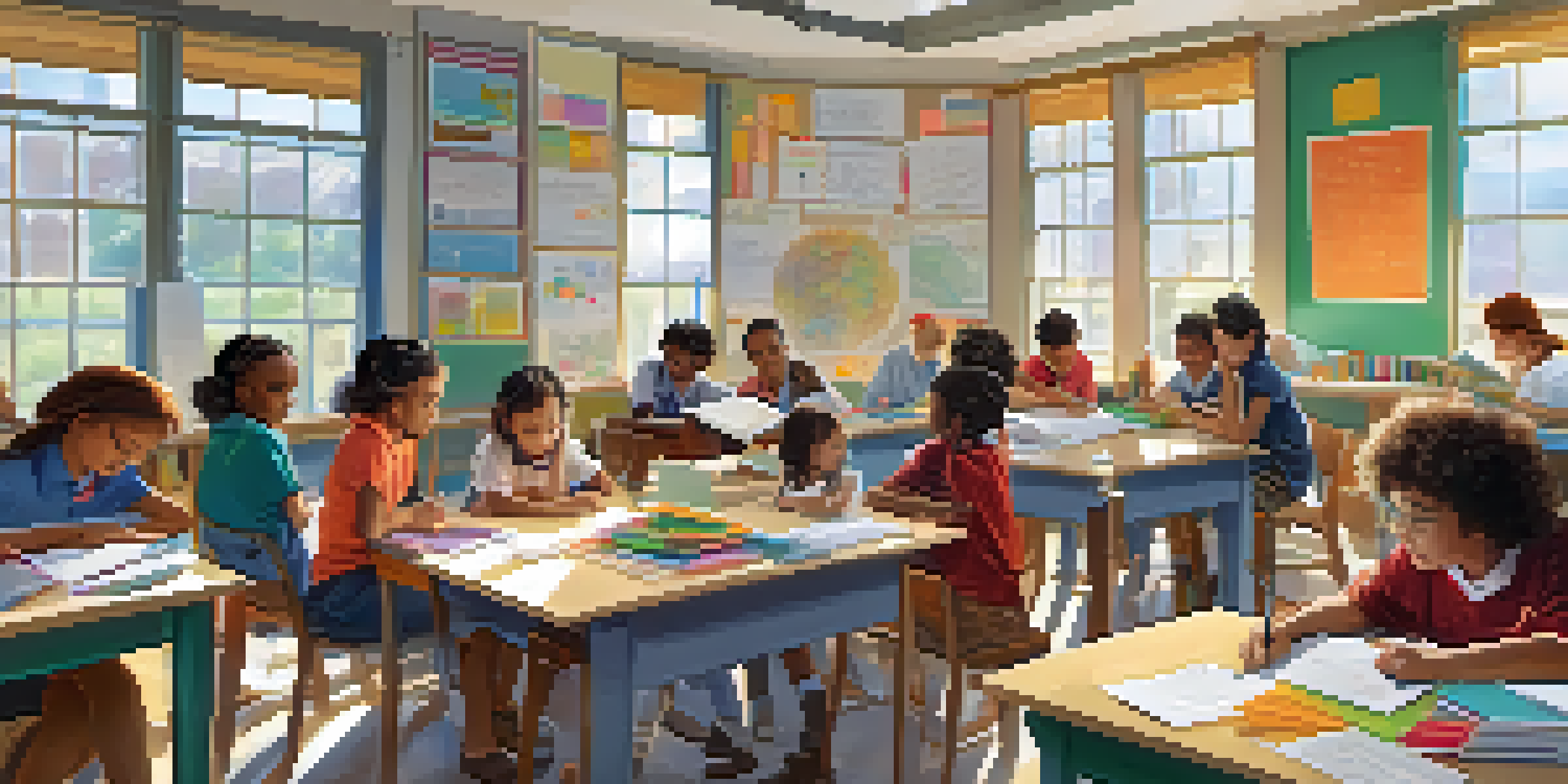Building a Culture of Collaboration in Educational Institutions

Understanding the Importance of Collaboration in Education
Collaboration in educational institutions is vital for fostering a supportive learning environment. When students and teachers work together, it enhances creativity and problem-solving skills, which are essential in today's world. This collective effort not only improves academic performance but also nurtures a sense of community among peers.
Alone we can do so little; together we can do so much.
Moreover, collaboration prepares students for the workforce, where teamwork is often crucial. By learning to collaborate effectively, students acquire interpersonal skills that will serve them well in their future careers. This dynamic interaction encourages students to communicate openly, share ideas, and respect diverse perspectives.
Ultimately, the importance of collaboration extends beyond the classroom. It cultivates a culture of inclusivity and mutual respect, which can lead to improved mental health and well-being for both students and educators. A strong collaborative culture can transform educational institutions into vibrant hubs of innovation and growth.
Creating Open Communication Channels Among Stakeholders
Open communication is the backbone of any collaborative effort. In educational institutions, establishing clear communication channels among students, teachers, and parents is essential for fostering collaboration. This can be achieved through regular meetings, newsletters, or digital platforms that allow for seamless information sharing.

When everyone is on the same page, it creates a sense of unity and purpose. For instance, involving parents in school events or decision-making processes can enhance the support system for students. This engagement not only strengthens relationships but also instills a shared responsibility for the students' success.
Collaboration Boosts Learning
Working together in educational settings enhances creativity, problem-solving skills, and fosters a sense of community.
Furthermore, encouraging feedback and suggestions from all stakeholders can lead to continuous improvement. When individuals feel heard and valued, they are more likely to participate actively in collaborative efforts. This culture of open dialogue ultimately contributes to a more cohesive and thriving educational environment.
Implementing Collaborative Learning Techniques in Classrooms
Collaborative learning techniques can transform traditional classrooms into interactive learning spaces. Group projects, peer teaching, and brainstorming sessions encourage students to work together toward common goals. These methods not only make learning more engaging but also help students develop essential teamwork skills.
Collaboration allows us to know more than we are capable of knowing by ourselves.
For example, consider a science project where students must collaborate to design an experiment. This hands-on approach allows them to share knowledge, divide tasks, and learn from one another. Such experiences can deepen understanding and retention of the subject matter while fostering a sense of accomplishment.
Moreover, incorporating technology can enhance collaborative learning experiences. Tools like shared online documents or project management apps enable students to collaborate in real-time, regardless of their physical location. This flexibility promotes inclusivity and ensures that all students can contribute to group efforts.
Encouraging Peer Mentorship and Support Programs
Peer mentorship programs can significantly enhance collaboration within educational institutions. By pairing students with mentors, schools create a supportive network that encourages personal and academic growth. This not only helps mentees gain confidence but also allows mentors to develop leadership skills.
For instance, older students can guide younger peers through challenging subjects or help them navigate school life. This mentorship fosters a sense of community and belonging, making students feel valued and supported. As a result, it can lead to improved academic performance and emotional well-being.
Open Communication is Key
Establishing clear communication channels among students, teachers, and parents fosters unity and shared responsibility for student success.
Additionally, these programs can bridge gaps among diverse student populations. By promoting understanding and respect for different backgrounds, peer mentorship can create a more inclusive and harmonious educational environment. This culture of support ultimately strengthens the overall collaborative spirit within schools.
Leveraging Technology to Enhance Collaborative Efforts
In today's digital age, technology plays a crucial role in fostering collaboration in education. Online platforms and tools can facilitate communication and project management among students and teachers. For instance, using tools like Google Classroom can streamline assignments and encourage collaborative discussions.
Moreover, technology allows for greater accessibility and flexibility in learning. Students can collaborate on projects from anywhere, using various devices to contribute their ideas. This adaptability helps accommodate diverse learning styles and schedules, making collaboration more achievable for everyone.
However, it's essential to strike a balance between technology and face-to-face interactions. While digital tools can enhance collaboration, personal connections foster trust and deeper relationships. Combining both approaches can create a well-rounded collaborative environment that benefits all stakeholders.
Recognizing and Celebrating Collaborative Achievements
Recognizing and celebrating collaborative achievements is vital for reinforcing a culture of collaboration. When educational institutions acknowledge the efforts of students and teachers, it motivates them to continue working together. Celebrations can range from simple shout-outs in meetings to awards for outstanding collaborative projects.
For example, hosting an annual collaboration fair where students showcase their group projects can highlight the importance of teamwork. Such events not only encourage participation but also foster pride in shared achievements. Recognition can inspire others to engage in collaborative efforts and contribute to a positive school culture.
Technology Enhances Collaboration
Leveraging digital tools facilitates effective teamwork and accommodates diverse learning styles, ensuring everyone can contribute.
Additionally, celebrating successes creates a sense of belonging and community. When individuals feel appreciated for their contributions, it strengthens their commitment to the collective mission. This culture of recognition ensures that collaboration remains a core value within educational institutions.
Continuous Improvement Through Feedback and Reflection
Continuous improvement is key to maintaining a culture of collaboration in educational institutions. Implementing regular feedback mechanisms allows students and teachers to reflect on their collaborative experiences. This process helps identify strengths and areas for growth, ensuring that the collaborative efforts remain effective and relevant.
For instance, conducting surveys or holding reflection sessions can provide valuable insights into what works and what doesn't. By encouraging open discussions about collaboration, institutions can adapt their strategies to better meet the needs of their community. This iterative approach fosters a growth mindset, where everyone is committed to learning and evolving together.

Ultimately, embracing feedback and reflection as part of the collaborative process strengthens relationships and enhances overall effectiveness. It empowers individuals to take ownership of their learning and collaboration, creating a more resilient and adaptive educational environment. This commitment to improvement ensures that collaboration remains a driving force in educational success.